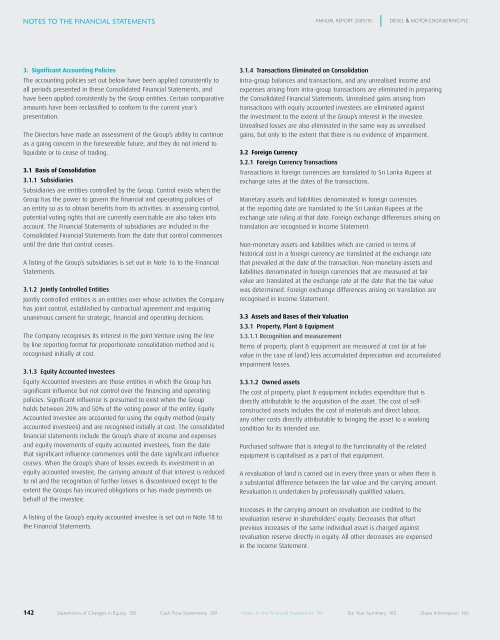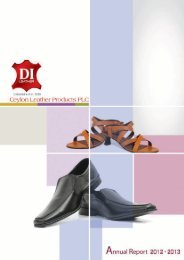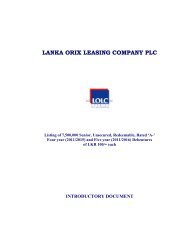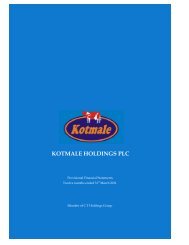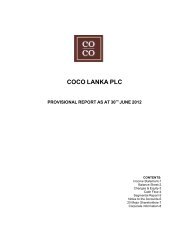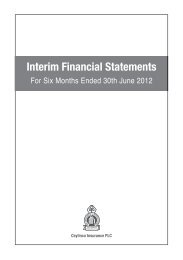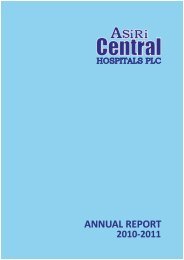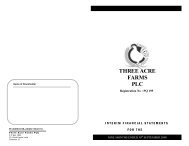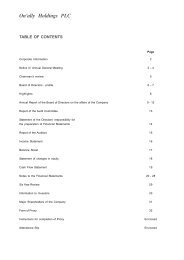directors - Colombo Stock Exchange
directors - Colombo Stock Exchange
directors - Colombo Stock Exchange
You also want an ePaper? Increase the reach of your titles
YUMPU automatically turns print PDFs into web optimized ePapers that Google loves.
notes to the Financial statements<br />
3. Significant Accounting Policies<br />
The accounting policies set out below have been applied consistently to<br />
all periods presented in these Consolidated Financial Statements, and<br />
have been applied consistently by the Group entities. Certain comparative<br />
amounts have been reclassified to conform to the current year’s<br />
presentation.<br />
The Directors have made an assessment of the Group’s ability to continue<br />
as a going concern in the foreseeable future, and they do not intend to<br />
liquidate or to cease of trading.<br />
3.1 Basis of Consolidation<br />
3.1.1 Subsidiaries<br />
Subsidiaries are entities controlled by the Group. Control exists when the<br />
Group has the power to govern the financial and operating policies of<br />
an entity so as to obtain benefits from its activities. In assessing control,<br />
potential voting rights that are currently exercisable are also taken into<br />
account. The Financial Statements of subsidiaries are included in the<br />
Consolidated Financial Statements from the date that control commences<br />
until the date that control ceases.<br />
A listing of the Group’s subsidiaries is set out in Note 16 to the Financial<br />
Statements.<br />
3.1.2 Jointly Controlled Entities<br />
Jointly controlled entities is an entities over whose activities the Company<br />
has joint control, established by contractual agreement and requiring<br />
unanimous consent for strategic, financial and operating decisions.<br />
The Company recognises its interest in the Joint Venture using the line<br />
by line reporting format for proportionate consolidation method and is<br />
recognised initially at cost.<br />
3.1.3 Equity Accounted Investees<br />
Equity Accounted Investees are those entities in which the Group has<br />
significant influence but not control over the financing and operating<br />
policies. Significant influence is presumed to exist when the Group<br />
holds between 20% and 50% of the voting power of the entity. Equity<br />
Accounted Investee are accounted for using the equity method (equity<br />
accounted investees) and are recognised initially at cost. The consolidated<br />
financial statements include the Group’s share of income and expenses<br />
and equity movements of equity accounted investees, from the date<br />
that significant influence commences until the date significant influence<br />
ceases. When the Group’s share of losses exceeds its investment in an<br />
equity accounted investee, the carrying amount of that interest is reduced<br />
to nil and the recognition of further losses is discontinued except to the<br />
extent the Groups has incurred obligations or has made payments on<br />
behalf of the investee.<br />
A listing of the Group’s equity accounted investee is set out in Note 18 to<br />
the Financial Statements.<br />
142<br />
ANNUAL RepoRt 2009/10 DIeseL & MotoR eNGINeeRING pLC<br />
3.1.4 Transactions Eliminated on Consolidation<br />
Intra-group balances and transactions, and any unrealised income and<br />
expenses arising from intra-group transactions are eliminated in preparing<br />
the Consolidated Financial Statements. Unrealised gains arising from<br />
transactions with equity accounted investees are eliminated against<br />
the investment to the extent of the Group’s interest in the investee.<br />
Unrealised losses are also eliminated in the same way as unrealised<br />
gains, but only to the extent that there is no evidence of impairment.<br />
3.2 Foreign Currency<br />
3.2.1 Foreign Currency Transactions<br />
Transactions in foreign currencies are translated to Sri Lanka Rupees at<br />
exchange rates at the dates of the transactions.<br />
Monetary assets and liabilities denominated in foreign currencies<br />
at the reporting date are translated to the Sri Lankan Rupees at the<br />
exchange rate ruling at that date. Foreign exchange differences arising on<br />
translation are recognised in Income Statement.<br />
Non-monetary assets and liabilities which are carried in terms of<br />
historical cost in a foreign currency are translated at the exchange rate<br />
that prevailed at the date of the transaction. Non-monetary assets and<br />
liabilities denominated in foreign currencies that are measured at fair<br />
value are translated at the exchange rate at the date that the fair value<br />
was determined. Foreign exchange differences arising on translation are<br />
recognised in Income Statement.<br />
3.3 Assets and Bases of their Valuation<br />
3.3.1 Property, Plant & Equipment<br />
3.3.1.1 Recognition and measurement<br />
Items of property, plant & equipment are measured at cost (or at fair<br />
value in the case of land) less accumulated depreciation and accumulated<br />
impairment losses.<br />
3.3.1.2 Owned assets<br />
The cost of property, plant & equipment includes expenditure that is<br />
directly attributable to the acquisition of the asset. The cost of selfconstructed<br />
assets includes the cost of materials and direct labour,<br />
any other costs directly attributable to bringing the asset to a working<br />
condition for its intended use.<br />
Purchased software that is integral to the functionality of the related<br />
equipment is capitalised as a part of that equipment.<br />
A revaluation of land is carried out in every three years or when there is<br />
a substantial difference between the fair value and the carrying amount.<br />
Revaluation is undertaken by professionally qualified valuers.<br />
Increases in the carrying amount on revaluation are credited to the<br />
revaluation reserve in shareholders’ equity. Decreases that offset<br />
previous increases of the same individual asset is charged against<br />
revaluation reserve directly in equity. All other decreases are expensed<br />
in the Income Statement.<br />
statements of Changes in equity 138 Cash flow statements 139 Notes to the financial statements 141 ten year summary 165 share Information 166


